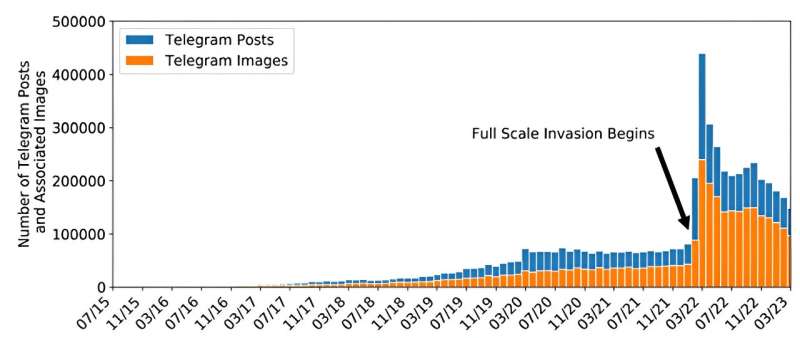This article has been reviewed according to Science X's editorial process and policies. Editors have highlighted the following attributes while ensuring the content's credibility:
fact-checked
preprint
trusted source
proofread
Experts say use of political memes are a predictor of political violence

In a study of social media activity prior to Russia's full-scale invasion of Ukraine, researchers at the University of Notre Dame say a sharp increase in politically salient imagery online—visual content designed to influence, dehumanize, manipulate and motivate audiences—was a predictor of the conflict.
With collaborators at Colby College and Kennesaw State University, the researchers collected post history from a select group of 989 Russian milbloggers—a term used for "military bloggers" who tend to post about military or war matters.
The Russian group's content, which regularly focused on Russia and Ukraine relations, was posted to the social media platform Telegram between October 2015 and March 2023 to a total of more than 5.3 million posts and 3.2 million images.
Using a combination of subject matter expert and AI analysis, the study showed an 8,925% increase in the number of posts and a 5,352% increase in images posted by the same accounts two weeks prior to Russia's full-scale invasion on Feb. 24, 2022.
The research is published on the arXiv preprint server.
"What we see is a massive campaign," said Tim Weninger, the Frank M. Freimann Collegiate Professor of Engineering, director of Graduate Studies in Computer Science and Engineering at Notre Dame and co-author of the study.
"That kind of rapid increase shows that, yes, there is predictive power to these social media campaigns. When we see a giant amount of propaganda being spun up on platforms like Telegram, it means something is impending. These are precursors to an eruption of violence."
Weninger is an expert in disinformation and fake news. He has studied how dehumanization is used in the lead-up to hostilities and helped develop an early warning system to fight disinformation online.
To analyze data on such a massive scale, the research team used artificial intelligence, computer vision techniques and forensic analysis to identify a subset of posts leading up to and immediately following the invasion—a total of 144,048 images—all of them posted between Feb. 15 and March 15, 2022.
Subject matter experts in political violence and Russian-Ukraine relations, including Ernesto Verdeja, associate professor of peace studies and global politics at Notre Dame's Kroc Institute for International Peace Studies and the Keough School of Global Affairs, performed a two-stage analysis of the images and identified politically salient narratives.
"Using this sophisticated AI system in conjunction with a group of experts on political violence and Russia and Ukraine, we were able to trace in near-real time not only the sharp rise in visual social media, but also the kinds of narratives that shape political discourse and drive instability," said Verdeja.
Previous research has shown that politically salient image patterns—propaganda by way of visual content—have been used to sow discord and even threaten the integrity of democratic elections. But Weninger said the research team wondered if such activity could also be a real-time warning sign of politically motivated violent events.
In their analysis, the research team focused on three key functions of politically salient images in instability contexts, exploring how images may promote in-group solidarity, out-group vulnerability and epistemic insecurity.
"Wherever there is political instability, these are the kinds of stories that are told," Weninger said. "So, the question is, 'Do we see these stories told in propaganda efforts and social media?' Indeed, we do. This is a definitive example—proof—of propaganda efforts on social media predicting violence."
He added that it's important to note not every instance of violent conflict will come with a barrage of social media beforehand, such as the current war between Israel and Hamas—in which case he saw no buildup of politically salient content prior to Hamas' attack on Israel on Oct. 7, but observed an increase in the aftermath of that attack.
The study's analysis of video and imagery is significant. "The emotional impact of a video or an image is so much more than a tweet," he said, and a big reason why TikTok and YouTube Shorts are so popular.
"Modern social media is images and short videos," Weninger said. "That's what no one in the field was looking at—that's what we are working toward monitoring."
More information: William Theisen et al, An Avalanche of Images on Telegram Preceded Russia's Full-Scale Invasion of Ukraine, arXiv (2024). DOI: 10.48550/arxiv.2402.14947
Journal information: arXiv
Provided by University of Notre Dame





















